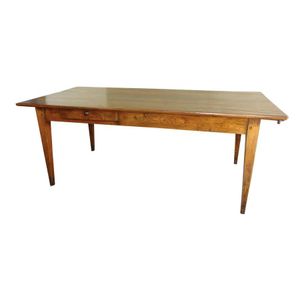Louis XVI Parquetry Writing Table
You must be a subscriber, and be logged in to view price and dealer details.
Subscribe Now to view actual auction price for this item
When you subscribe, you have the option of setting the currency in which to display prices to $Au, $US, $NZ or Stg.
- Parquetry - Parquetry is inlay laid in geometric patterns, the contrast being achieved by the opposing angles of the grain and veneers. The herringbone pattern is the most commonly used in flooring, but this is almost never seen in furniture - the patterns used are more complex and unlike flooring, can include several different varieties of timber.
- Inlay - Decorative patterns inserted into the main body of a piece of furniture, generally in wood of contrasting colour and grain, though brass, ivory, ebony, shell and sometimes horn have been used. Inlay may consist of a panel of well figured timber inset into a cabinet door front, geometric patterns, or complex and stylized designs of flowers, swags of foliage, fruits and other motifs. As a general rule, in pieces where the carcase is constructed in the solid, the inlay is relatively simple such as stringing, cross banding and herringbone banding. Where more elaborate and decorative work was required veneer was used. Inlay has been fashionable from at least the latter half of the 17th century, when a variety of elaborate forms were developed
- Provenance - A term used to describe the provable history of an antique or work of art, and thus an additional aid to verifying its authenticity. Provenance can have an inflating effect on the price of an item, particularly if the provenance relates to the early settlement of Australia, a famous person, or royalty. Less significant are previous sales of the item through an auction house or dealer.
This item has been included into following indexes:
Visually similar items

Antique Regency mahogany fold over tea table

Goldfields kitchen table possibly Chinese maker, eucalypt and pine, Bendigo area Victoria, 19th century 75 cm high, 165 cm wide, 73 cm deep

A good mid-19th century French elm farmhouse table, the plank top with pull-out extension to one end, single short drawers, pegged detail and internal taper to the square section legs, good colour and patina. 199.5 cm (unextended) x 93 cm x 75 cm

A Georgian style mahogany side table, 19th century, with single pullout drawer which is, decorated with a boxwood inlay border. The legs are tapered with brass castor feet. Height 77 cm. X 81.5 x 47 cm (top)
